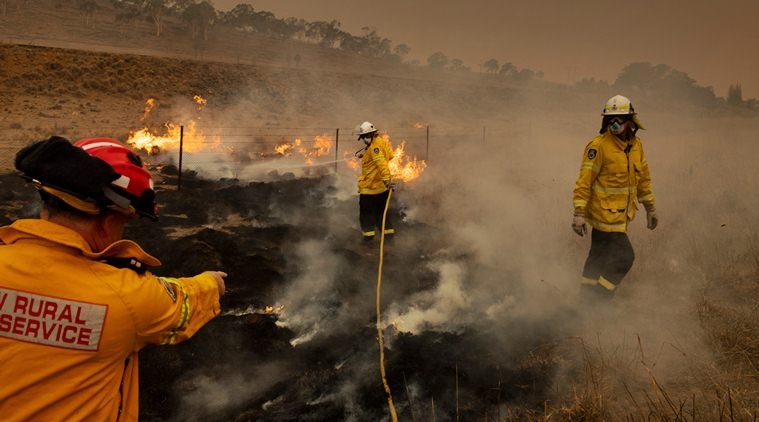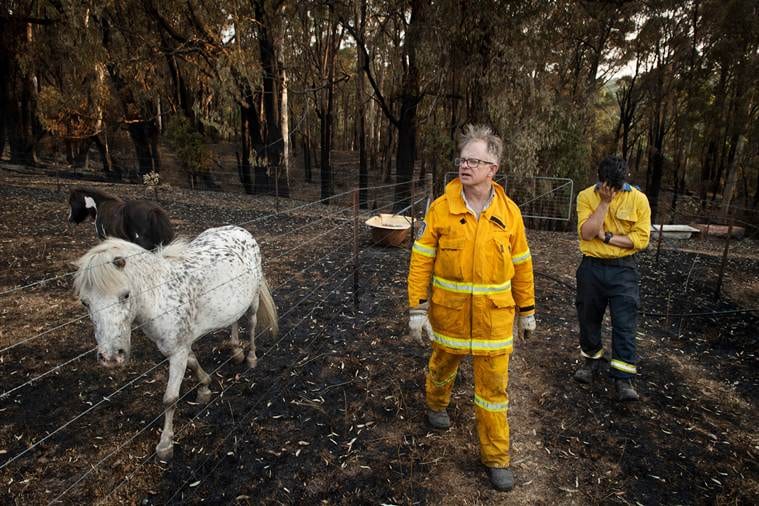 Fire fighters work to stop a fire near Bredbo, New South Wales, Australia, Feb. 1, 2020. (Matthew Abbott/The New York Times)
Fire fighters work to stop a fire near Bredbo, New South Wales, Australia, Feb. 1, 2020. (Matthew Abbott/The New York Times)
Written by Damien Cave and Matthew Abbott
Most of the fires Michael Blenkins has put out since becoming a volunteer firefighter in the 1980s required little more than rushing to a nearby farm and hosing down ankle-high flames. In and out in maybe an hour, then back to work as a teacher.
When he persuaded his eldest son, Edmund, to join the rural fire brigade at 16, he thought less about danger than camaraderie. But in Australia, climate change and the huge fires it fuels have obliterated the old normal. Instead of the usual three or four days a year, the Blenkinses have been fighting fires around their mountain town, Batlow, on and off for a month. They have repeatedly put in 12-hour days. And the danger has been immense: On Jan. 4, they nearly died in a firestorm.
“There were flames kicking up everywhere,” Blenkins, a formal man with an even manner, said one recent day, a dress shirt peeking out from under his firefighter gear. “It was like the Titanic — we thought we were prepared to handle it, and we weren’t.”
For more than a century, Australia has managed the landscape by drawing on the altruism and kinship of its people. In challenging terrain colonized after the United States, it was not the mythical cowboy who tamed the Australian frontier; it was the egalitarian collective, farmers working together to protect the land, with fire as the primary threat.
That culture of shared responsibility across a sparsely populated continent still holds. Even on the worst fire days this season, around 90% of the firefighters battling blazes have been volunteers like Michael and Edmund Blenkins, a ratio unmatched in any other developed country where wildfires rage.
 Michael and Edmund Blenkins survey damage to their family property on the outskirts of Batlow, New South Wales, Australia, Jan. 9, 2020. “There were flames kicking up everywhere,” said Michael, who became a volunteer firefighter in the 1980s. “It was like the Titanic — we thought we were prepared to handle it, and we weren’t.” (The New York Times)
Michael and Edmund Blenkins survey damage to their family property on the outskirts of Batlow, New South Wales, Australia, Jan. 9, 2020. “There were flames kicking up everywhere,” said Michael, who became a volunteer firefighter in the 1980s. “It was like the Titanic — we thought we were prepared to handle it, and we weren’t.” (The New York Times)
But their agonizing efforts reveal more than just the help-thy-neighbor bravery that has won Australia’s volunteers global acclaim. Their experience also points to the risks, tensions and burdens of a new bush-fire era. Fire experts describe what’s happening as a new phenomenon, which the country is confronting with a firefighting strategy from the past.
Climate change has made an arid nation even more combustible and deadly. Today’s blazes are monstrous omnivores that have charged through more than 43 million acres of forests, small towns and coastal suburbs since July, according to Australia’s Department of Home Affairs, with around 100 fires still burning.
“I can imagine no system that could handle as many fires, and as intense fires, over such a breadth of country as Australia has faced this long, long season,” said Stephen Pyne, a fire historian at Arizona State University. But, he added, “the brigades were designed for a different time and set of conditions.”
The toll on firefighters is mounting: On Jan. 23, three American crew members were killed when their firefighting plane crashed in the Snowy Mountains; 11 firefighters in all have died this season. And climate scientists predict that future years may be even worse.
Prime Minister Scott Morrison has promised that Australia will adapt to the threat through technological change, but he has ruled out moving away from fossil fuels or sharply reducing the country’s emissions. Instead, after being sharply criticized for a delayed response, he has preferred to work around the edges of the problem, with more money for aerial firefighting and calls for investigations into bush-fire management.
Many firefighters are now demanding a more ambitious reevaluation. Some want compensation and professional training. Others want better equipment and more help with preventive burning of undergrowth, along with tougher building standards, and maybe even a carbon tax that would raise money to bolster firefighting and reconstruction.
What they agree on is that something has changed. A few days of firefighting have turned into weeks and months, and with summer not over until March, the work is not yet done.
Volunteers all over Australia quietly admit in interviews that they have felt at times as if they were fighting against hell all alone. Pay, they say, matters less than training, competence and candor about what they are facing, not just now but in the future.
“We’ll be fighting these fires for months,” Edmund Blenkins said. “If it’s not here, it will be somewhere else. And then there will be more.”